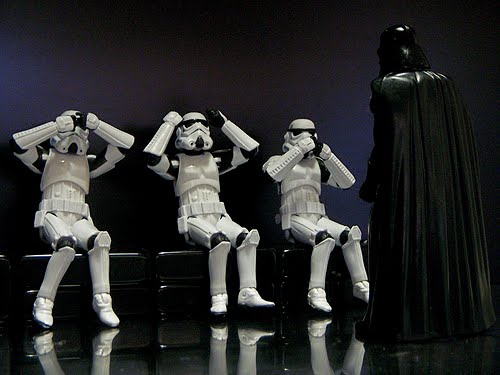The Terrible Mind of Chuck Wendig
Late yesterday I wrote a short post about
Chuck Wendig's fun writing challenge and someone joked I should write about how he works his
writerly magic.
I LOL'd back and didn't think much more of it until I saw Chuck had written an article on editing.
Oh! I thought.
This will be interesting. THEN I found out he'd written about ... drum roll ...
how he writes a novel!
It was like the sky split open and trumpets sounded. How could I
not write about that?
(All quotations, unless stated otherwise, are from Chuck's blog post:
How Chuck Wendig Writes A Novel.)
1. The Right Idea
Every story begins with an idea. But not just
any idea. It has to be the
right idea.
How do you know which one is right?
Chuck puts his ideas through a kind of interrogation. I'm not sure what he does with the ones that don't make it and I'm sure it's better that way.
The right idea will be:
a) interesting to me beyond the moment in which they are conceived
b) potentially interesting to other humans who are not me
c) potentially interesting to the giant amorphous blob known as the “publishing industry”
d) about a character in a world and not just a world
e) and de actionable, meaning, an idea that suggests a book I’m actually capable of writing
The idea that makes it through the final inerview goes on Chuck's "idea list". He writes:
[L]ater I dump it into a file I’ve created that’s meant to be a storehouse
of such potential ideas. For the record, this dump file now looks like
the warehouse at the end of Raiders of the Lost Ark. Shelves and shelves of crates and boxes, each a mystery container whose story remains untold.
If I could make a humble suggestion:
Dropbox and
Google Drive are your friends.
If you keep your important lists in the cloud, you're guaranteed to have an updated version of the lists on your computer(s) as well as in the cloud (wherever that is) so even if the worst happens and all your electronic devises spontaneously combust you'll still have your ideas, your stories and your Excel worksheets.
2. Barf Up A Blob Of Incoherent Thoughts
I love Chuck's headings. I mean, right off, you knew that was his, right?
Anyway, the second step is to get your thoughts out of your head and out into the world: put them on a sheet of paper, virtual paper, spreadsheet programs, mind-maps, whatever works for you. As Chuck writes:
The notes taken at this stage are almost stream-of-consciousness.
Sentence fragments, mis-spelled words, grocery list thoughts
interspersed in the middle, whatever. It’s just to ruminate on the idea.
And it’s also to test the idea in a way. Is there more here than than
initial idea? A great many ideas are dead seeds planned in fallow ground
— they won’t grow a good goddamn thing. So, this stage of the game is
very much about seeing if this thing has legs. Will it walk? Can it run?
3. Get To Know Your Characters
Chuck calls characters "The way through every story". You need to know who a character is in the same way you need to know what the story is about (we'll get to that in a moment).
a. Name your characters
Names have power. I find it difficult to write about a character before I have some idea what her first name is. Last names are the trickiest, often they won't come to me until I'm working on my second or third draft.
Naming resources:
- Websites for baby names
- Google Map street names
- Scrivener
- US census data
- Movie credits
- The names of characters from other books, mixed and matched.
b. Take your characters out for dinner and get to know them
For each character ask:
- What are his wants? (Both conscious wants and unconscious.)
- What are his needs?
- What are his fears?
- Why does he need to keep going?
- What goal will drive him as he progresses through the story?
- What obstacles are in his path? Which obstacles will prevent him from reaching his goal?
Some of these obstacles MUST be bound up with what the character fears.
c. Create a simple character arc: Beginning, middle, end
Chuck writes:
Finally, I do a little three-beat character arc for the character.
Three words or sentences that are meant to indicate the state of the
character across the story — beginning, middle, and end.
Poor cat down on his luck wants to see a change in this country –>
elected president, way over his kitty head –> once again a poor cat
but now knows the intimate details of the democratic process and oh did I
mention he nuked the middle of our own country into oblivion.
d. The test: Are your characters compelling?
Some writers want their characters to be likable. Chuck doesn't. He wants characters that are interesting, readable and, above all,
compelling.
Why do you find your character compelling? What are they good at?
What have they failed at? What events have made them who they are?
4. Ask The Foundational Question: What Is Your Story About?
Answering this question will help you begin to not only lay the foundation of your story, but it will also test your story idea to make sure it's really one you want to spend months of your life with.
Here is
the big question:
What is your story about?
I love examples, don't you? So, before we go any further, here are examples of what Chuck means when he asks: What is your story about
?
“This is about how you can’t escape your past.”
“This is about just how fucked up people can be.”
“This is about how the education system fails its kids by adhering to
antiquated ideals and stats that don’t mean anything and notions of
‘learning’ that remain separate from notions of ‘humanity.’”
“This is about the coming of age of MONKEY SQUID DEATH WOMBAT. Raaaaar!”
I tend to think of stuff like this as THEME. Just the other day someone asked whether he should know the theme of his story before he started to write or if it could be worked into the story later.
If I remember what he wrote in
On Writing, Stephen King often doesn't know what his story is about until the second draft. The theme is there, but he hasn't discovered it yet.
Chuck Wendig is definitely a
know your theme first kinda guy and I do see his point.
Why you want to know what your story is about before you begin writing
In his article
Before You Start Writing, Ask: “What Is This About?”Chuck points out that knowing your theme before you start writing has a number of benefits.
i. It will tell you why you are writing this story
Answering the question,
What is this story about?, will tell you what you want to say.
In order for the story to work you need to write about something
more than what interests you, you need to write about what
compels you, what
haunts you.
ii. Binds your story elements together
Knowing what the story is about will tell you why you're writing it and THAT is the mortar which binds your story elements together. Chuck writes:
Point is, the web, the structure, the whole recipe comes together when
you have this answer. You can look at the whole picture, nod, and just
say, “Ohhhh.”
iii. Gives you a thread
Knowing what your story is about is like being handed a magical thread that will help you find the way through the labyrinth of your story. It will help you decide what to do.
Just as in a labrynth you need to decide, "Do I go right, left or straight?" when you write you're going to be presented with choices. How does a particular character react to such-and-such? How does she respond when she fails to achieve one of her goals?
Knowing what the story is about will help you understand what needs to happen next, where to turn, how to proceed.
iv. The test: How you know if you've found out what your story is about
If the answer to, "What is your story about?" doesn't get you excited, if it doesn't connect with you emotionally, then that's not your answer. Keep excavating. Chuck writes:
If you don’t love the answer, and that answer doesn’t get you all
jizzity-jazzed about the process of writing this thing, then ... that’s not your answer. The answer needs to engage you. It needs to
excite you. It needs to give you purpose and be the lash on your
ass-cheeks to spur you forward. (Before You Start Writing, Ask: “What Is This About?”)
Now let's move on to talk about
how we can discover what our story is about, how we can discover our story's theme.
5. The Marvels Of Mind-Mapping
At this point we've got some character sketches and, maybe, a vague idea of what our theme is but nothing we can pin down. What we need is a much clearer idea of what brings all these disparate elements together. We need a handle on what our story is
about. What is its theme?
We need to create a mind-map.
What the heck is a mind-map?
Chuck has written an excellent article on this:
Who The Hell Are These People? Mind-Mapping Your Story’s Characters. In that article he has embedded an image of a mind-map he created. You can get there through Chuck's article or you can
click here. Here's how Wikipedia describes a mind-map:
A mind map is a diagram
used to visually outline information. A mind map is often created
around a single word or text, placed in the center, to which associated
ideas, words and concepts are added. Major categories radiate from a
central node, and lesser categories are sub-branches of larger branches. Categories can represent words, ideas, tasks, or other items related to a central key word or idea. (Mind map)
Why use a mind-map?
- It's easy, fun, gives you a lot of information at a glance.
- It is simple to do and can be done anywhere (you can do it on your smartphone).
- It helps you explore character without locking you into anything. It doesn't feel as serious, as written in stone, as when you're sitting at your desk typing away.
- It can help you spot themes, a deeper storyline.
It's this last point I want to spend a moment on. Chuck writes:
I was going through the characters [using a mind-map], and I started to see some similar elements pop up: elements of legacy, of family, of blood. And I was like, holy shit, I just figured out what this whole story’s *about.* I mean, I had the story in mind. I know a rough sequence of events for the plot. But I didn’t really have a deeper throughline.
And in the mind-map, the character’s exposed themselves (tee-hee) and showed me the theme of the piece.
Just through the act of dicking around with fun little word bubbles and connective tissue, I suddenly stumbled upon one of my great unanswered questions, a question I didn’t think I’d answer so soon.
That’s the joy of the preparation process. It’s like preliminary archaeology. You dig and dig and uncover things you never expected to find. (Who The Hell Are These People? Mind-Mapping Your Story’s Characters)
Sounds great!
I've never used a mind-map before but after reading Chuck's articles I'm going to give it a try.
One
of the benefits of using a mind-map is that you can get an app for your
phone and do it anywhere. Chuck even recommends an app:
SimpleMind.
6. Write A Pitch
I was excited when I read this, because it's what I've been saying in my Starburst Series!
a. Write a logline/elevator pitch
Sum your entire novel up in a single sentence. Chuck uses his 'cat for president' story idea as an example:
A cat is elevated from poverty and is elected president only to learn
that cats shouldn’t ever serve in public office because cats are
assholes.
b. Write a blurb
Write a longer pitch of under 500 words. Basically you want a longer version of the blurb for the back cover of your book without giving spoilers. But this should be easy since you don't know exactly what's going to happen.
7. Build A World, But Be Like Scrooge
Chuck cautions that writers should do only as much work as you have to in order to begin writing. You don't know what material is going to get cut so only do the bare minimum.
For instance, in one story I'm working on I knew I needed a slow moving mammal but I didn't know what kind would fit so I just wrote <slow moving mammal> in my first draft and moved on.
8. Know Your Beginning And Your End
Figure out how your story begins as well as how it ends. Chuck writes:
Here’s why I like to have the beginning and the ending in mind: because
as I write, my eventual outline will fail me. It just will. No plan
survives contact with the enemy and eventually I’ll be somewhere in the
middle of the book, spinning wildly in the swampy mire of my own fiction
not sure exactly what to do next. And when that happens I will look to
the ending and I will say, “I need to go there,” and then I
will march the story toward that point and eventually get the outline
(which by now may require modification) back on track.
Make sure there is an element that links your beginning and your ending
This element could be
elemental,
thematic or
physical. For instance,
In the Mookie Pearl short story, “Charcuterie,” it begins and ends with
him pulling up at the bar with his friend and boss, Werth.
9. Outline
Chuck Wendig uses a four act structure. Christopher Vogler uses four as well but Michael Hauge uses three. TV has gone to a six act structure. It's up to you, whatever works.
Write the key scenes first
Chuck figures out what needs to happen in the story (something which is much easier to do if you have an ending!) and then writes those key scenes.
Write the dramatic scenes second
Also, there may be a few different
kinds of scenes you want to enclude such as a:
- reversal of fortune
- a key betrayal
- a battle scene
- a moment of shock or, as Chuck puts it:
I’m also always on the look out for at least one HOLY SHIT NO HE DIDN’T
moment — some jaw-dropping pants-crapping event or revelation in the
narrative that sticks you in the ribs with a story shiv. I like those
moments. One of my favorite things is obliterating reader expectations
in one fell swoop.
10. Let It Sit
At this point you've got a fat-ish folder, either physical or electronic, and you may need to let the story sit for a bit before you nail yourself to your chair and write it.
11. Spreadsheets Are Your Friends
Chuck Wendig keeps his writing schedule in an Excel spreadsheet. He writes:
One spreadsheet I particularly require is the one that keeps all my
writing schedule on it. I don’t use a calendar — I use Excel. I have the
whole year planned out in terms of when my deadlines are and where the
books slot in. (Then I also identify gaps and, ideally, figure out how
to best use those gaps.)
Mark down when your writing projects need to be completed then write down how much you know you can finish per day (underestimate a little to give yourself a bit of wiggle room) and figure out how much time you'll need to complete each one.
For me, it's not so much the writing that takes time, it's the editing. My rule of thumb is that for every hour writing I reserve 4 hours for editing. (Of course I never edit what I just wrote! Gah! The very thought burns!) I'm learning--or trying to learn--how to juggle multiple projects at different stages of completion.
Also, on your spreadsheet keep track of both your
projected and your
actual word count.
12. Write
Chuck writes:
I write. I write with my head down. I write linearly, first page to the
last page. I write without listening to the doubting voice that tells me
I’m a total asshole for even trying this. I write without regard to
safety or sanity. I write with the freedom to suck and the hope that I
don’t. I write to finish the shit that I started.
That's (basically) it! Chuck Wendig has written another article on how he edits his stories and you can find that here:
How Chuck Wendig Edits A Novel.
This was a gargantuan article! Sorry about that. I try to keep my blog posts to 1,000 words or less but I'm in the process of writing three different series and I didn't want to add a fourth, so I wanted to get this post done today.
I'll be briefer tomorrow. :-)
Other (much shorter!) articles you might like:
-
Using Excel To Outline Your NaNoWriMo Novel: Defeating the sprawl
-
Mary Robinette Kowal and The Mysteries of Outlining
-
The Starburst Method of Writing
Photo credit: "
Free Old Converse All Stars Creative Commons" by
Pink Sherbet Photography under
Creative Commons Attribution 2.0.










